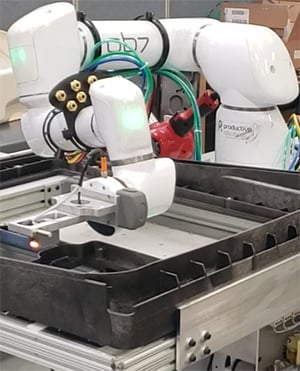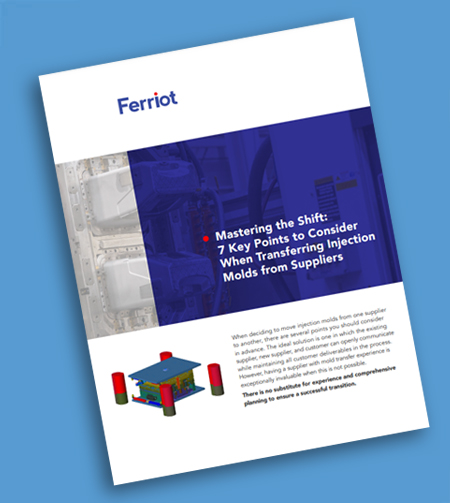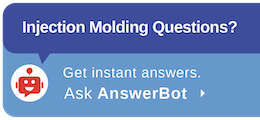Cobots & Vision Systems for Custom Injection Molded Parts
In our last article, I spoke with Jeff Hodnick, our Automation Engineer, about how Ferriot is integrating new automation technologies, such as 3D printing and custom end-of-arm tooling design. Previously, we outlined how Ferriot utilizes cobots to enable more efficient manufacturing in injection molding.
In this installment, Jeff shares additional details on how Ferriot uses the latest cobots and vision systems to strategically enhance the Ferriot workforce while increasing throughput and assuring quality.
 Liz: A few years ago, we wrote about how Ferriot used our new cobots in manufacturing. Since then, you’ve been utilizing them even more. How are you using them lately? What are some of the things our people can now do instead of the processes the cobots are taking care of?
Liz: A few years ago, we wrote about how Ferriot used our new cobots in manufacturing. Since then, you’ve been utilizing them even more. How are you using them lately? What are some of the things our people can now do instead of the processes the cobots are taking care of?
Jeff: So right now, we have one that does some of the dual plastic-on-plastic welding out in our molding department. And then we also have another one where we rotated between an ultrasonic welder and a pad printer back in our finishing department.
In all three use cases, it’s allowed us to take what would be a two-to-three-operator job and bring it down to one. Plus, we have our insert welder on a cobot. Using that approach, we can weld and move the part around approximately three times faster than a typical human operator—without the fatigue a person would experience. As a result, the new approach frees up space and at least one person on everything we deploy to the cobot.
We’re in the process of evaluating the addition of two more cobots to our operations. I’m working on the justifications and planning out the required first deployment steps.
Liz: Since you’re looking into more, how much has the cobot technology changed since you bought the first two?
Jeff: Technology has continued to move forward and become more sophisticated. More than anything, they’ve become even more reliable. There are more options from which to choose. We’re evaluating several different brands; most have auto-synchronizing features. For us, rapid deployment, changing molds all the time, being able to quickly move a robot right in front of a belt and synchronize all the accesses and be able to deploy it within 20 to 30 minutes is huge. I’ve been to the Automate Show in Detroit, which is the largest robotics and automation show in North America. As far as technology changes, we are seeing more reliability and flexibility. All the cobot technologies are making significant strides. Everything is so much more reliable. Conversely, I wish I could say it was easier to get spare parts, but we all know how supply chain issues are right now.
Liz: What are some of the other benefits of cobots?
Jeff: One of the most significant benefits is protection and shielding requirements are minimal. You don’t necessarily have to build a large cage around them. Don’t misunderstand. You still have to put up some protection whenever you’re using cutters, grinders, and stuff like that, in conjunction with them. But, for the most part, they’re pretty hands-off. The second they touch anything else that they’re not supposed to, they stop almost right away. They’re outstanding about all that. There’s a whole lot more intelligence there than there used to be.
Liz: When it comes to the companies that make the cobots, they tend to tout the value prop that your people can do something else, and that’s kind of vague. Let’s be specific. At Ferriot, what can our people do instead because the cobots are now performing these functions?
Jeff: Primarily, we can simultaneously have more active presses because, instead of needing two or three operators dedicated to a single press to run a job, you only need one. This approach results in better labor dispersion, where we can run more presses since we have the people to run them, and we can better deploy our people to the most active, time-sensitive projects. This provides great cost improvements due to lower labor overhead and allows us to help our customers save on part cost.
Additionally, I’m working on a project with the two new cobots I mentioned earlier where we’d be able to have them handle a lot of parts processing. So, all we need people to do is walk between presses and handle packing the parts.
In cases where we’re doing all the post-processing with the robot, we classify it as half an operator because the operator doesn’t have to wait an hour for parts to be processed. They can split their time between two to three presses at once, packing the parts once they reach a certain quantity at each of the presses. So, it improves our efficiency and labor dispersion.
Liz: How are we using the vision systems along with the cobots?
Jeff: The vision systems are another technology that, while they’ve always been around, the ease of programming and implementation has recently improved in the last few years. Today, these systems are much more flexible, and easier to use. While we have three systems, we actively use two as part of our quality control.
Imagine a part that takes a hundred (or more) inserts, and because there’s such a low volume run, we can’t automate it. As a result, sometimes an insert or two isn’t put in place properly. In situations like that, we have a vision system that’ll check both sides of a part.
We have smaller vision systems that have hot-swappable nests. So, you can use the same exact system, switch between programs and check for a multitude of parts simultaneously. Being able to universally adapt vision systems has been a huge win for us.
Liz: How were those processes handled before having the vision systems?
Jeff: They were mostly manual, dependent on our quality inspectors, Very time and labor-intensive.
Liz: And so, with the use of the vision systems again, like the cobots, those people that used to do those labor-intensive jobs that took a more extended period of time, what are they now doing?
Jeff: Again, it’s about strategically dispersing the personnel. We have those vision systems in our finishing department. So instead of only running one or two different parts to that department a day, we’re currently running four to five different parts—with different things being worked on widely across it—and sometimes it’s even more than that. Our wider dispersion of labor, enhanced with an automation workforce, enables us to get more done, more accurately, with greater throughput and quality assurance.
Liz: In summary, what the cobots and vision systems do for our customers is they bring that consistency that no matter how hard a human being tries, they just can’t do. At some point, the human operator gets fatigued.
Jeff: Exactly. The robot sub stand eliminates that issue while saving time. We even have instances where we’ve put vision systems and inspection systems on the end of a cobot.
Liz: How does that work?
Jeff: We created a custom end-of-arm instead of the normal extruded aluminum. We made it out of a solid piece of aluminum, but we were able to mount a couple different sensors and wire them that way. By doing that, we were able to create a tray where an operator sets a part and then presses a button. A button is only required when we need to ensure the operator is out of the way. Once they hit the button, the robot will individually check for each insert, it’ll check depth gauges in key areas, making sure everything is in the correct positions. The robot extends over top of the entire part, completing the whole inspection.
An example is retail fueling dispenser bezels. We’re using the robot and vision system combination for inspection. Basically, the operator sets the bezel, also called the front housing, onto the fixture. Then the robot goes through and inspects each part of it, making sure everything is in correctly. There are secondary sensors as well.
Automation using cobots and vision systems are tools Ferriot uses to streamline processes which improve productivity and save labor overhead cost. These efforts ultimately help to minimize part cost and improve throughput.




